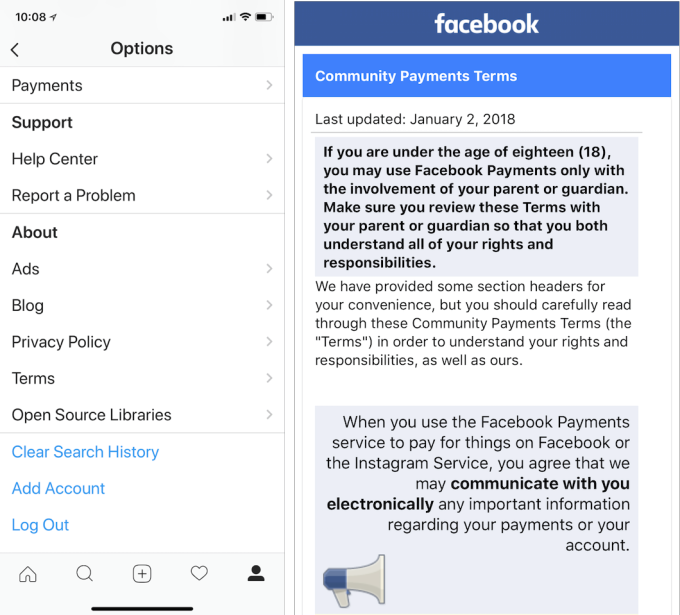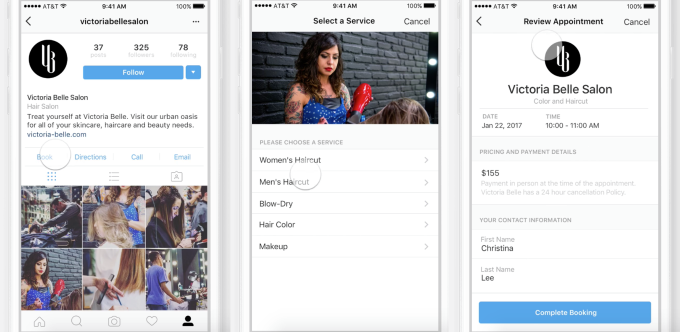Yes, you read the headline correctly: Instagram recently added a native payment feature on its app for some users!
This is huge news and something I’ve been waiting for for years!
In this article you’re going to learn how native payments on Instagram work and the opportunities they provide to e-commerce stores in the future.
How native payments work on Instagram
First of all, this feature is not available to all users yet.
There is no information about native payments on the Instagram business blog, which leads me to believe they are currently testing the feature and we may be a year or so away from global rollout.
You can see if your account has the payment feature available by logging in to the Instagram app, going to ‘Options,’ and seeing if you have the Payments tab available.

Photo from Tech Crunch
For users under the age of 18, they must first obtain permission from their parent or guardian before making any purchases. In the payment settings, you will be able to add either a debit or credit card and a security pin as two-factor authentication.
There are no options yet to add other payment methods such as PayPal.

As of right now, native payments through Instagram have been limited to appointment-based businesses such as local restaurants and hair salons. By using the booking feature, users can directly book a table for lunch or a hair cut through a business’ Instagram page using the pre-built booking form.

Native payments cannot be used in ad or post formats as of yet.
Instagram is battling Snapchat
A few months ago Snapchat began testing their Snap Store, where users could buy products directly off the app. The entire shopping process was simple and easy.
Instagram’s biggest competitor right now is Snapchat, and it shouldn’t come as much of a surprise that they too have started offering native payment features.
If, or rather when, this feature rolls out globally, it’s going to be a huge tool for e-commerce businesses to use at the middle and bottom of their funnels to retarget uses with dynamic product ads (DPAs).
Native payments will no doubt increase impulse purchases and make the customer buying journey a lot smoother. One would assume that this feature will eventually be combined with Instagram shoppable posts, which is going to make Instagram an invaluable place for businesses to position themselves online.
Businesses can now start to refine their Instagram funnels from start to finish without having to link out to their website, giving them huge potential to decrease their customer acquisition costs.
The downsides of native payments
Accepting payments on a third-party platform like Instagram comes with its own set of potential problems.
E-commerce payment platforms like Shopify and PayPal take a small percentage fee for every transaction made on their platform, and while I don’t see it happening any time soon, what’s to stop Instagram from taking a percentage of the revenue from every sale made in the future?
Naturally, you won’t have as much customer information if payments are made using a third-party processor, which may impact your ability to make decisions when making future plans.
Native payments on Instagram make it so much easier for your customers to shop at other businesses too. Assuming they don’t need to create an account to make a purchase as their information is already on Instagram, it reduces the barrier to entry to shop at new stores, potentially impacting your customer lifetime value.
This is just me playing devil’s advocate and offering an unbiased opinion of the pros and cons of native payments. Personally, I think it’s going to be a great feature for e-commerce businesses, and some thought will need to go into refining your Facebook and Instagram marketing strategy to minimize the above from happening.
What are your thoughts on Instagram native payments?
Earlier this year, Facebook was in hot water about data privacy, so I expect Instagram to take the introduction of native payments on its app slowly.
It’s an exciting feature for sure, and it further cements how important Instagram is as a platform for businesses selling tangible products.
How will you use this new native payment feature?